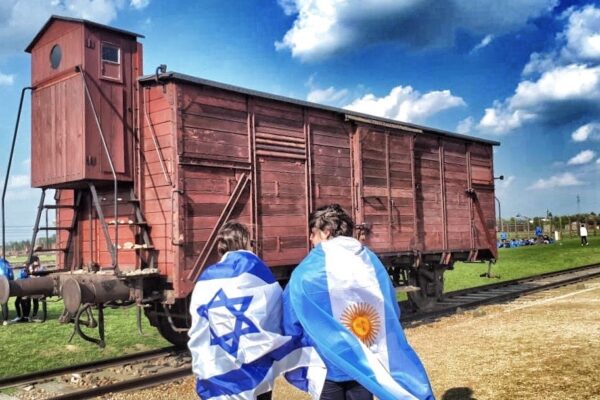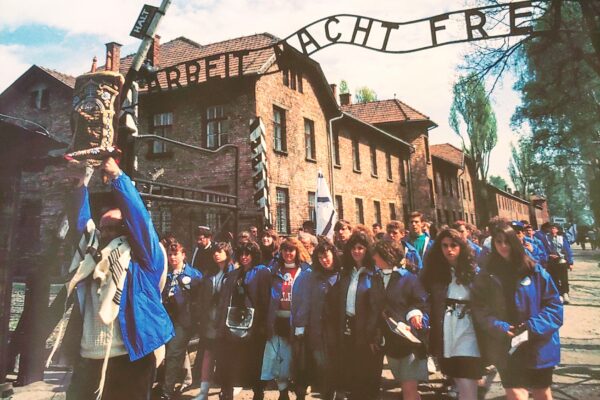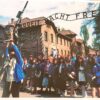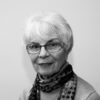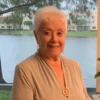The March of the Living brings together different generations of the same family, providing a narrative of life among unspeakable pain and a message of renewal
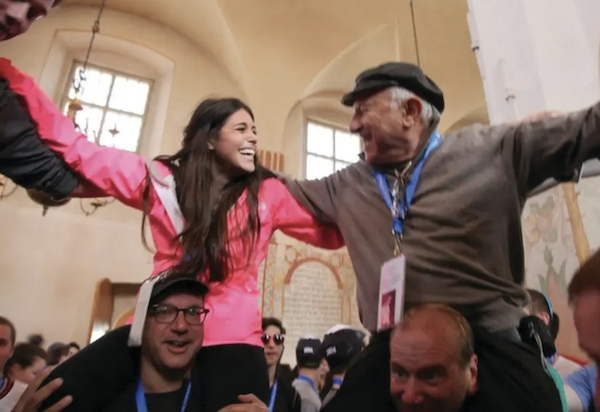
Nate Leipciger and his granddaughter, Jennifer Gree, take part in the March of the Living in Poland. (photo credit: Courtesy)
Those words, “always remember who are,” were the last ones that Anita Ekstein’s father spoke to her, as he entrusted her safety to a Polish coworker, who had promised to save her. It is a mantra that she has lived by since then; from being hidden in a Catholic priest’s house on the Russian-Polish border until the end of the war, to the beginning of a new life in Canada and now, transmitting her story and testimony to the younger generation.
“These trips take a lot out of you,” she said. “It is very difficult – emotionally and physically – and going with my grandchildren to the camps – especially Belzec (where her mother was killed). I love those kids and I want them to know these stories so they can take them on.” To that end, anticipating a time when she can no longer travel on the March, the Azrieli Foundation will publish Ekstein’s memoir Always Remember Who You Are in 2019.
The March, of course, does not just deeply affect the grandchildren of survivors – and even those without such a personal connection continue to ruminate on their experiences and ask questions. Ekstein expressed the hope that the young adults to whom she has spoken and will continue to do, will remember her story and what she has taught them – affectionately recalling how a student, years after the March reached out to ask for additional information. “The young people who listen to me – and other survivors – they will not forget.”
Like Ekstein, Nate Leipciger is participating in his 18th March of the Living, noting how the emphasis and character has changed over the years. “When I started, the March had a negative note when we went to Poland. [It seemed] that we only went to commiserate and commemorate the demise of our people. We did not study the history of who these people were and that there had been Jewish life in Poland for 1,000 years before the Shoah. We only talked about how they died, not how they lived!”
Leipciger felt that this change of emphasis, from death and destruction to also including life and renewal, added an important dimension and greater texture to the experience. “Life did not begin and end with the Shoah,” he said, “I wanted to talk about my wonderful experiences before and explain that this terrible episode in our long history is not my raison d’etre and should not be the mainstay of Judaism.”
Being able to return to the scene of one of humanity’s worst crimes with children and grandchildren in tow, is a compelling rejoinder to the plan for the annihilation of the Jewish people.
Leipciger was speaking having just celebrated the bris of his great-grandson; an event that his granddaughter, Jennifer Green, recalled did not leave a dry eye in her brother’s house. It is this message of renewal that Leipciger was keen to stress, arguing that thousands of young, knowledgeable, bright and dedicated Jewish students traveling to Poland – highlight the Jewish people’s victory over its enemies – albeit a very costly one. “It is a march of life,” said Leipciger, “how can that make you feel? Hitler gave me a one-way ticket to Auschwitz and I came back with thousands of others.”
Ruth Ekstein, Anita’s daughter, highlighted the feeling of surprise coupled with that very palpable sense of having returned from the precipice and defeating evil, on one of the marches on which she accompanied her mother. The surprise emanated from feeling that she had immersed herself as deeply as possible in learning everything about the Shoah. “My mom is very vocal and one of the top educators,” she said, “there was not a survivor I had not met, nor a book I had not read.” Despite this, nothing could prepare Ekstein for the reality of visiting Auschwitz. “Confronting evil – really seeing it – was remarkable and it shook me up, but being there with all those students was spectacular.” A moment of high emotion and lasting impact would shortly follow. “That first year I was there, my mom walked arm-in-arm between me and my daughter [from Auschwitz to Birkenau]. We got to the top of the hill and both in front and behind, were kids and Israeli flags as far as the eye could see. My mom suddenly burst into tears. ‘Look at all of these kids! Don’t you understand I was not supposed to be here, you were not supposed to be here, these kids were not supposed to be here. Hitler did not win!’”
In taking the painful emotional steps of considering how to transmit a survivor’s story when they are no longer with us, the power of memoir and testimony (albeit a more diluted form than first-hand recollections) is always close to people’s thoughts.
Arla Litwin, Leipciger’s daughter, said that the gentle push to try and encourage survivor’s to write and publish their memoirs was a fantastic development, while acknowledging that “nobody could ever take the survivor’s place – nobody can make it as poignant as when there is a survivor present.” (The Azrieli Foundation recently published her father’s memoir, The Weight of Freedom.)
She, like many of the second and third generation, plan to carry the torch of memory as best and as much as they can – and continue to be active in Holocaust remembrance.
Ruth Ekstein added that an exciting new development was the trialing of New Dimensions in Testimony (NDT) a collaboration between the Shoah Foundation and the University of Southern California’s Institute for Creative Technologies (ICT). Former Auschwitz prisoner, Pinchas Gutter, was the first survivor to be filmed using the technology, with hundreds of questions about his life before and during the war asked of him – and his answers recorded. The Toronto Holocaust Education Center wants to utilize this technology as a way to keep on telling the story. “It is very weird because I want him,” Ekstein said of Gutter, whose memoir Memories in Focus the Azrieli Foundation published earlier this year, ‘but it is quite extraordinary and really captures him.”
What marks out so many survivors is that they are neither hateful nor bitter – values and morals they have inculcated in their children and grandchildren. For Green, her life-changing moment appeared when she and her grandfather walked through a gas chamber.
On exiting, Leipciger recognized an elderly Pole, who as a younger man had worked at the camp, and embraced him, not for a second bearing a grudge against someone – assuming the best in others even if relations between Jews and Poles (who were higher up in the camp hierarchy) in Auschwitz may have not been ideal. “It was beyond inspiring and one of those moments that I could always look back on and ask, ‘What would my grandfather do in a particular situation?’”
For Michelle Ekstein, Anita’s granddaughter, the time that really brought home what it meant to be a survivor was a visit to Belzec – where Anita Ekstein lost all of her family. “To be able to go that sacred place with my grandmother and hear her give over her story was amazing,” she said. “I walked hand-in-hand with her – and we stopped by the monument of first names and found the one which represented her mother – then lit a yarzheit (memorial) candle. That moment brought things to life – about separating being an Ekstein from being a Jew.”
In wanting to broadcast a message to this year’s participants, the advice from all the interviewees was consistent. For Leipciger, a crucial element is being able to teach young people at a time when they are sensitive know what education means and can understand the message without traumatizing them. Litwin advised the youngsters to be truly present, participate as much as they can and really take in the information. “I have seen people go and shut themselves off, afraid of exploding with emotion. It is a unique experience and also a privilege to be there.” Green and Ruth and Michelle Ekstein concurred, but added another element to their message.
They all acknowledged that they were lucky to have grown up in a country where they were free to express themselves as they saw fit, in particular as Jews in support of Israel. They were aware – and perhaps the current political climate in parts of Europe and North America is testimony to this – that with freedom and opportunity comes responsibility and obligation. They entreated students and young adults to do something positive with the knowledge and experiences they will gain – and to also not be embarrassed to ask survivors what may at first seem upsetting questions. “If you are able to give back, you have to give back – with your ears and with your love – going on the march does that for people. For everyone who hears first-hand testimony, when you come home, share the survivor’s story and make life choices in light of that,” Green implored. “You cannot be a bystander – the other part of ‘Never Again’ is also that it must not happen to anyone, anyplace or anytime – do not just assume that everything will be okay. There is a duty to ensure no other people go through what we went through.”

